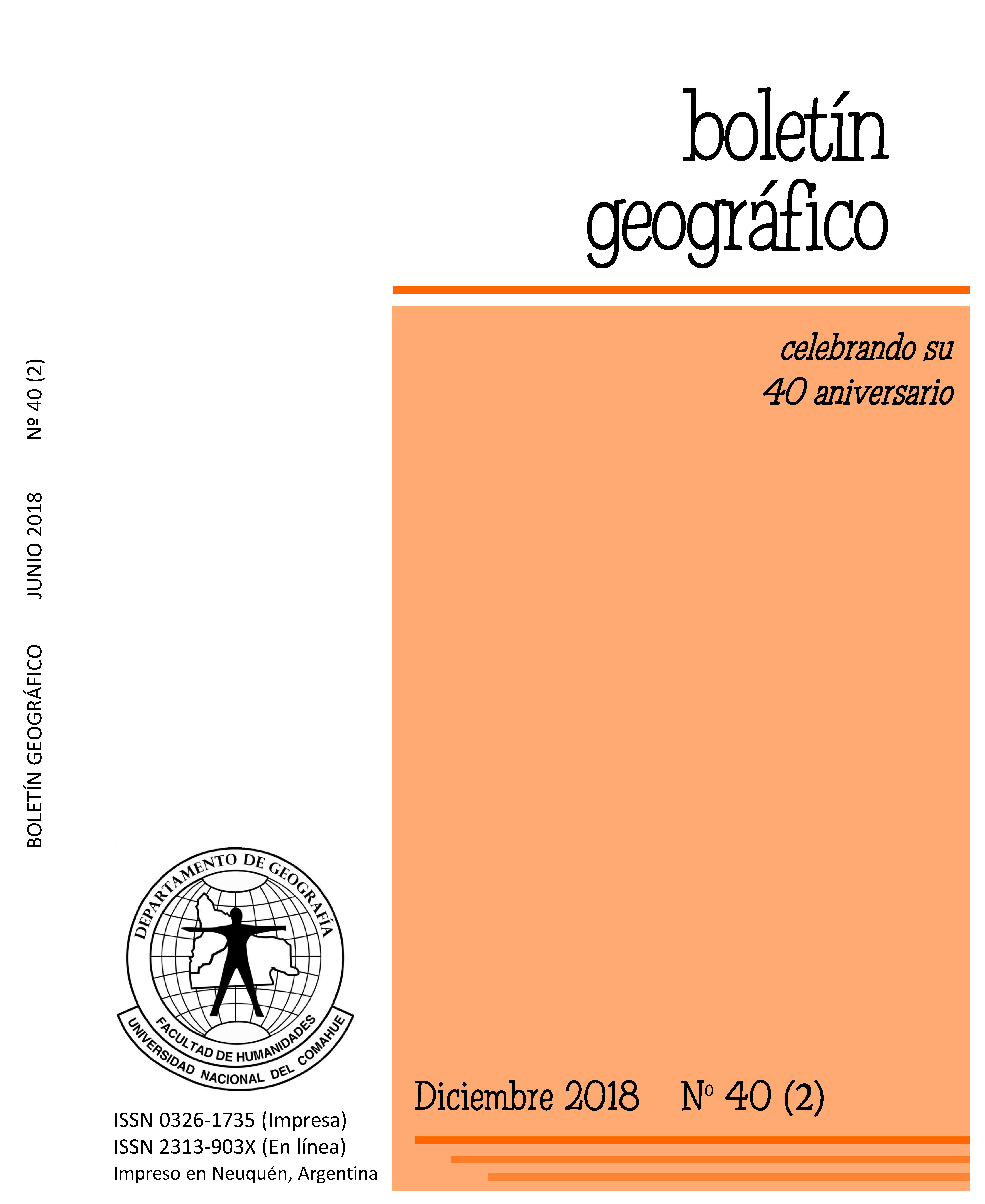MEAN MONTHLY WATER BALANCE IN NEUQUÉN, ARGENTINA
Keywords:
Thornthwaite, Water budget, Evapotranspiration, RunoffAbstract
In recent years there has been an increase in the average temperature in different regions, which is associated with an increase in evapotranspiration, causing greater deficit and water stress in areas with arid climates. The climate of the Province of Neuquén presents a marked gradient of precipitations west-east, in areas near the mountain range of the Andes stand out cold winters with rains and snowfalls, and summers drier and more temperate; to the east, precipitation decreases, presenting a semi-desert environment identified with the Patagonian steppe. The knowledge of theevolution of the different components of the water balance in arid zones is of
fundamental importance for the estimation of the coverage of the hydric requirements of the vegetation, and of the different productive activities that are developed in the area; as well as for the control of the state of the wetlands (mallines). In this work, the spatial variations of the moisture balance components are presented in detail from information from the network of surface meteorological stations in the province of Neuquén
Downloads
References
Cabrera, A. (1985). Enciclopedia Argentina de Agricultura y Jardinería. Tomo II.
Regiones Fitogeográficas Argentinas. Segunda Edición. ACME S.A.C.I.
Dai, A., Trenberth, K.E. & Qian, T. (2004). A global dataset of Palmer drought
severity index for 1870–2002: relationship with soil moisture and effects of surface warming. Journal of Hydrometeorology. 5, 1117–1130
Fasullo, J. & Sun, D.Z. (2001). Radiative Sensitivity to Water Vapor under All-Sky
Conditions
García N.O. (1994). South America Climatology. Quaternary International, 21, 7-27.
Garreaud, R. D., & Aceituno, P. (2001). Atmospheric circulation over South America: Mean features and variability. Chapter 2 in: The Physical Geography of South America. T. Veblen, K. Young and A. Orme, Eds. Oxford University Press.
Harris, I., Jones, P.D., Osborn, T.J. & Lister, D.H. (2014). Updated high-resolution
grids of monthly climatic observations – the CRU TS3.10 Dataset. International
Journal of Climatology, 34, 623–642. doi: 10.1002/joc.3711.
Jones P.D., Lister D.H., Osborn T.J., Harpham C., Salmon M. & Morice C.P., (2012):
Hemispheric and large-scale land surface air temperature variations: an extensive
revision and an update to 2010. Journal of Geophysical Research 117, D05127. doi:10.1029/2011JD017139.
Legates, D.R., & Mather, J.R. (1992). An evaluation of the average annual global
water balance: Geographical Review, 82, 253–267.
Mather, J.R. (1979). Use of the climatic water budget to estimate streamflow, in
Mather, J.R., ed., Use of the climatic water budget in selected environmental water problems: Elmer, N.J., C.W. Thornthwaite Associates, Laboratory of Climatology, Publications in Climatology, 32(1), 1–52
McCabe, G.J. & Markstrom, S.L. (2007). A monthly water-balance model driven by a graphical user interface: U.S. Geological Survey. Open-File report 2007-1088, 6 p.
McCabe, J.G. & Wolock, D.M. (2016). Variability and Trends in Runoff Efficiency
in the Conterminous United States. Journal of the American Water Resources
Association, 1-10. DOI: 10.1111/1752-1688.12431
Mintz, Y. & Serafini, Y.V. (1992). A global monthly climatology of soil moisture and
water balance. Climate Dynamics, 8: 13–27. doi: 10.1007/BF00209340
Osborn T.J. & Jones P.D. (2014). The CRUTEM4 land-surface air temperature
dataset: construction, previous versions and dissemination via Google Earth. Earth System Science Data 6: 61-68. doi: 10.5194/essd-6-61-2014
Prohaska, F. (1976). World Survey of Climatology. Climates of Central and South
America. Edited by W. Schwerdtfeger, Elsevier Scientific Publishing Company.
Cap. 2: The Climate of Argentina, Paraguay and Uruguay, 12, 13-112.
Thornthwaite, C.W. (1948). An approach toward a rational classification of climate: Geographical Review, 38, 55–94.
Trenberth KE (2011) Changes in precipitation with climate change. Climate Research 47:123-138. https://doi.org/10.3354/cr00953
Trenberth K.E., & Shea D.J., (2005) Relationships between precipitation and surface temperature. Geophysical Research Letters, 32.
L14703. doi:10.1029/2005GL022760
Wolock, D.M. & McCabe, G.J. (1999a). Explaining Spatial Variability in Mean
Annual Runoff in the Conterminous United States. Climate Research 11:149-159.
Wolock, D.M., & McCabe, G.J. (1999b). Effects of potential climatic change on
annual runoff in the conterminous United States: Journal of the American Water
Resources Association, 35, 1341–1350.
Yates, D.N. (1996). WatBal––An integrated water-balance model for climate impact assessment of river basin runoff: International Journal of Water Resources
Development, 12, 121–140.
Published
How to Cite
Issue
Section
License
Copyright (c) 2018 Boletin GeográficoTransfer of rights and data processing
The acceptance of an article for publication in the Journal Geographic Bulletin implies the cession of the rights of printing and reproduction, by any means and means, of the author in favor of the Department of Geography of the National University of Comahue, which will not reject any request reasonable for the authors to obtain permission to reproduce their contributions. The total or partial reproduction of the works published in the Geographic Bulletin must be done citing the origin, otherwise, the copyright is violated.
Likewise, it is understood that the concepts and opinions expressed in each work are the sole responsibility of the author, without being responsible or in solidarity, necessarily, neither the editorial staff nor the editorial staff.
It is the responsibility of the authors to be able to provide interested readers with copies of the raw data, procedure manuals, scores and, in general, relevant experimental material.
Likewise, the Management of the journal guarantees the appropriate treatment of personal data
COPYRIGHT TRANSFER FORM















 Journal of the
Journal of the 